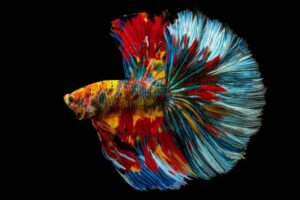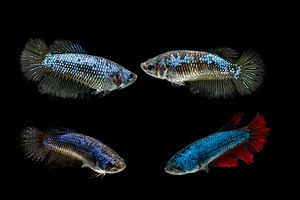Bettas or Siamese fighters are fascinating freshwater fish commonly kept as aquarium pets. They belong to the Osphronemidae family, which consists of various anabantoid fish species. Bettas can be found in a range of different colors and fin types, created by years of selective breeding. They are relatively easy to care for and maintain, making them popular for beginner fish keepers.
Whether you already own a betta or plan to, this article will discuss 12 incredible facts about them.
1. Betta’s Have Been in Captivity for a Millennium

Bettas are vibrantly colored freshwater fish.
©Patcharanat Sriboonruang/Shutterstock.com
Bettas have been in captivity for nearly a millennium (1,000 years), making them one of the longest domesticated fish species aside from goldfish. They originated from Southeast Asia with records of their association with humans dating back to the 14th century A.D.
Their country of origin is Thailand, previously known as Siam, and nearby countries like Indonesia and Malaysia. According to this study on their genome analyses, bettas have been kept for ornamental purposes since the early 20th century. They were previously used for fighting purposes because of their territorial and aggressive temperaments.
Around 150 years ago, bettas were collected in Thailand for human entertainment and were regulated by the King of Siam. Nowadays, bettas are kept as pets and bred to produce different colors and patterns.
2. They Can Breathe Oxygen From The Surface
Bettas have a unique adaptation that allows them to breathe atmospheric oxygen, just like humans do. This is possible with their labyrinth organ located above their gills. Their labyrinth organ fills with oxygen that can enter their bloodstream, which is different than when they take in dissolved oxygen via their gills. Bettas need this adaptation to survive in poor water conditions, like stagnant ponds or puddles with little dissolved oxygen.
However, this is not a bettas ideal way of living, and it is used for survival only. Betta fish still need proper living conditions to thrive in and not the subpar conditions they experience for a short period in the wild.
3. Male Bettas Are Solitary and Highly Territorial
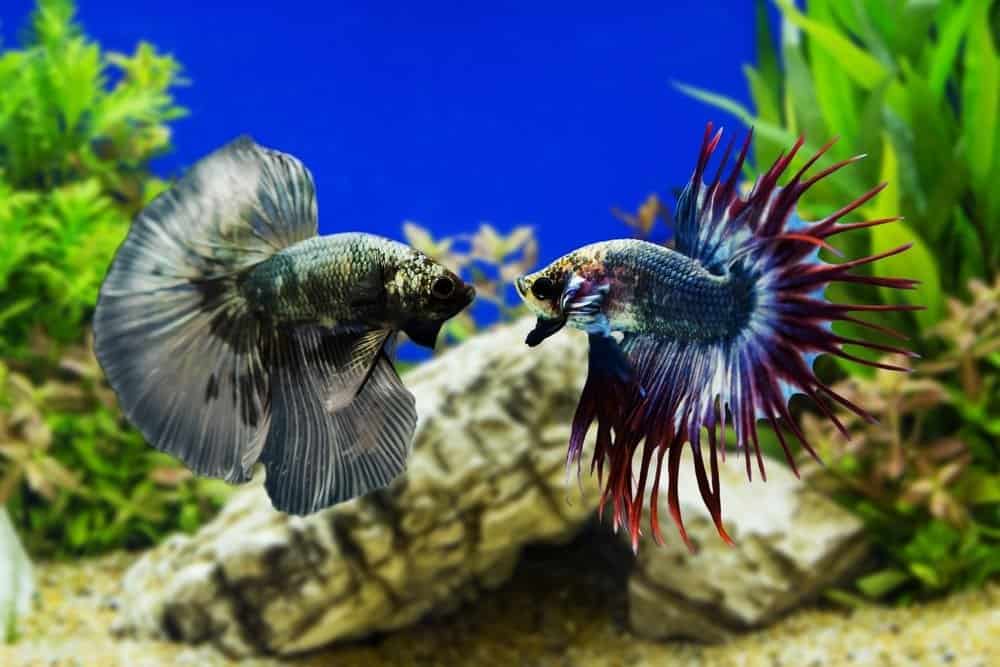
Don’t let their bright colors fool you, male bettas are solitary and will fight to death or fatal injury.
©subin pumsom/Shutterstock.com
Although both male and female bettas are territorial, male bettas are usually more aggressive than females. Once mature, male bettas have zero tolerance for other males in the same tank as them. This is why male bettas should never be housed together, even if you plan to give them a big tank and plenty of hiding spaces.
They will often fight till severe injury or stress, which can be fatal. If you plan to keep two male bettas, you will need to keep them in two different tanks with an appropriate setup. You ideally want to avoid placing the tanks together to avoid allowing the males to see each other through the glass.
4. Bettas Thrive in Spacious Fish Tanks and Not Bowls
There is a common misconception that betta fish can be kept in small bowls or vases. However, those living conditions are not suitable for bettas and do not make good permanent homes. The misconception likely stemmed from the rice paddies or puddles that bettas live in when their natural habitat dries up. These conditions are usually poor, and many bettas do not make it to the next wet season.
Wild bettas have no choice but to temporarily live in smaller bodies of water, which is why they can use a labyrinth organ to breathe. In captivity, you want to ensure that you can care for your betta properly rather than force them to live in improper setups.
They require a minimum of 5 to 10 gallons of water in a standard fish tank. You will need to run a heater and filter to keep their water quality ideal.
5. Male Betta’s Are More Colorful
Like male animals, the male betta is more colorful than the females. This is due to sexual selection and dimorphism. Both male and female bettas look different from one another, with the males being more brightly colored. Male betta fish are well-known for having vibrant colors and elaborate fins that make them more popular to keep.
Female bettas can also be found in different colors and patterns, but not as much as the males. Another distinguishing feature that sets the sexes apart is that males are typically larger and have longer fins than females.
6. They Build Bubble Nests
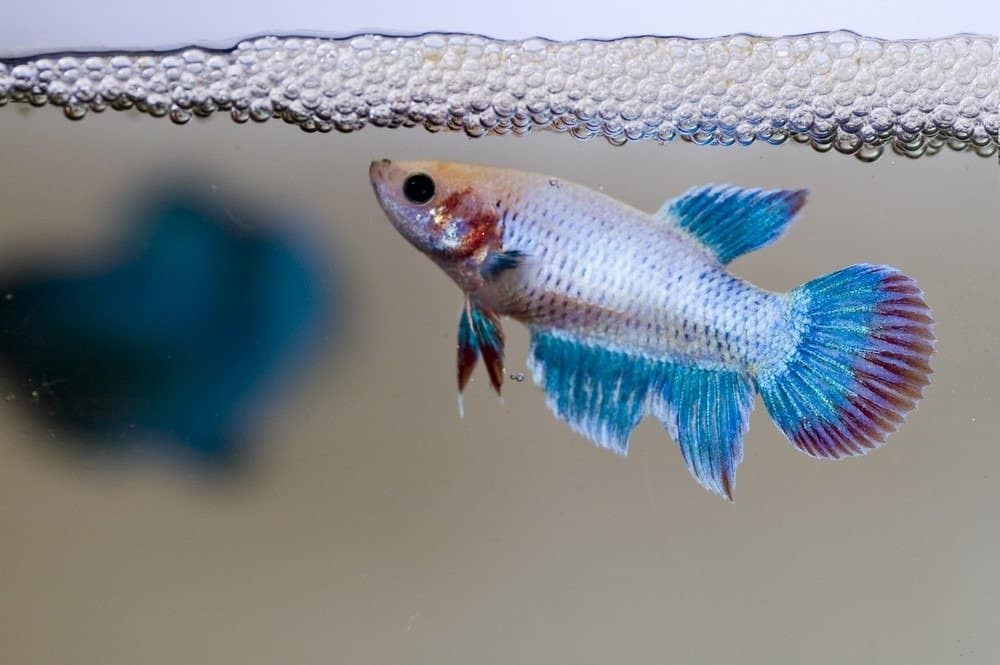
Bettas are mouthbrooders and protect the eggs in carefully constructed bubble nests.
©mnoor/Shutterstock.com
Betta fish have a unique way of reproducing and creating nests at the surface of the water. When a male betta fish is mature and ready to attract a mate, he will begin creating a bubble nest. He does this by gulping air into his mouth and expelling it at the water’s surface over and over again. The bubbles are covered in a mucous that helps to keep a rounded shape without popping.
The result is a cluster of tiny bubbles that might be mistaken as foam. The size of the bubble nest can vary depending on how much time the male is willing to spend creating it. If the water surface has a lot of movement from a filter or bubbler, then the bubble nest might be broken before you get to see it.
The male will use the bubble nest to protect the eggs he has squeezed out of his mate after fertilizing them.
7. Bettas Get Their Scientific Name From a Danish Doctor
A Danish medical scientist named Dr. Theodore Edward Cantor was responsible for the bettas scientific name. After receiving a pair of betta fish in the 1840s, Dr. Cantor decided that the scientific name Macropodus pugnax would be suitable. It roughly translated to a big-finned fish that is fond of fighting. However, that name was already taken, and the scientific name was later changed to Betta splendens in 1909.
8. Bettas Are Strictly Carnivores
Betta fish are carnivorous fish that prefer to eat a variety of insects and their larvae. In the wild, betta’s feast on brine shrimp, midge larvae, water fleas (daphnia), and crustacean larvae. However, bettas will eat vegetation if they have no other food sources to survive on. Their bodies are adapted to digest the nutrients and exoskeletons of insects rather than large amounts of plant materials.
In captivity, betta fish should be fed a specie-appropriate diet consisting of a high-quality pellet or flake food. Their diet needs to be high in protein, so consider feeding live or frozen foods a few times a week. Bettas are fond of live or frozen bloodworms, baby brine shrimp, daphnia, and mosquito larvae.
9. There are More Betta Fish Colors and Patterns Than We Can Count

Betta fish do not disappoint with their endless colors, patterns, fins, and scale variations.
©panpilai paipa/Shutterstock.com
There are nearly a hundred different betta fish colors and patterns, which is why these fish are so unique. Betta fish can be found in different colors like red, blue, green, black, opal, and orange. They display striking patterns like marble, koi, and bicolors. Some bettas have long fins like the halfmoon, while others have shorter fins in a plakat style.
These new varieties are continuously being produced by dedicated betta fish breeders. The original betta fish did not look nearly as spectacular as they do nowadays. The wild specimens that modern bettas originated from were a duller color with shorter fins.
10. Bettas Enjoy Resting On Leaves or Hammocks
There are few things a betta fish enjoys more than resting on a comfortable leaf or hammock in their tank. So much so that products labeled as “betta hammocks” have become popular in recent years. The hammock is usually in the style of an artificial leaf with a suction cup to be attached to the tank’s walls.
Some betta fish rest more than others, especially if they have long fins that weigh them down in the water. Heavy or long-finned betta fish sometimes struggle to swim for too long and prefer to rest in between.
Most bettas will prefer to rest on a leaf or soft surface rather than along the substrate. However, you should rule out any potential health problems, stress, or water quality issues that could be responsible for your betta’s inactivity.
11. Bettas Can Jump Quite Far
Bettas can jump impressively far, which is why you should always secure their tank with a fitted lid. Wild betta fish will jump to escape poor conditions, such as a drying up puddle or stagnant water. They will also jump to catch certain insects above the water line. If your betta is jumping from their aquarium, it is usually an indication that their environment is unideal.
This could be from having to live in small bowls or vases, or from poor water quality and inadequate water temperatures. So, while betta fish can jump, it is not a good sign if they keep jumping out of their aquarium.
If your betta has recently jumped from their aquarium and hasn’t completely dried out, try placing them in the aquarium to “revive” them before considering them dead.
12. There are Over 73 Species Of Betta Fish
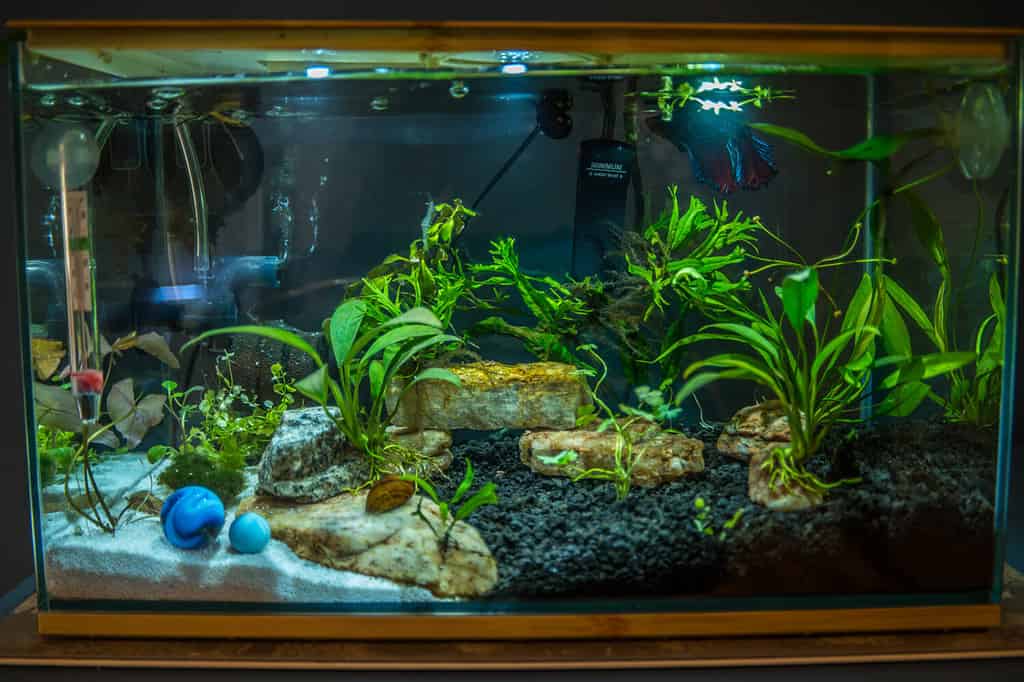
All betta fish deserve a filtered and heater tank over a small bowl or vase.
©Sandra Burm/Shutterstock.com
There are over 73 species of fish in the Betta genus, but only a handful are kept as pets. It is one of the most diverse genus in the Osphronemidae family of labyrinth fish. The B. anabantoid (giant betta), B. imbellis (peaceful betta), and B. splendens (Siamese fighter) are the most popular species in captivity. The different species can range in size and color forms, but the B. splendens are more morphologically diverse.
The species are grouped into different complexes, including the following:
- B. akarensis complex
- B. albimarginata complex
- B. anabatoides complex
- B. coccina complex
- B. dimidiate complex
- B. edithae complex
- B. picta complex
- B. pugnax complex
- B. splendens complex
- B. unimaculata complex
- B. waseri complex
Thank you for reading! Have some feedback for us? Contact the AZ Animals editorial team.





